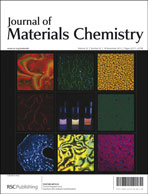Here we demonstrate a facile approach to the fabrication of transferrable and high-quality latex colloidal masks with tunable interstice size for nanosphere lithography (NSL). A polystyrene (PS) monolayer colloidal crystal (MCC) was first prepared via an air–water interface self-assembly method and subsequently transferred onto the surface of water in a hydrothermal reactor. Thermal annealing of the PS colloidal monolayer floating at the water surface under a temperature higher than the glass-transition temperature of polystyrene caused deformation of the PS spheres, leading to the shrinkage of the interstice. By manipulating the diameter of the colloidal spheres and the thermal annealing process, flexible control in size, shape and spacing of the interstice in a colloidal mask was achieved, which would facilitate the broad use of NSL to study the size-, shape-, and period-dependent optical, magnetic, electronic, and catalytic properties of nanoparticle arrays.
You have access to this article
 Please wait while we load your content...
Something went wrong. Try again?
Please wait while we load your content...
Something went wrong. Try again?


 Please wait while we load your content...
Please wait while we load your content...